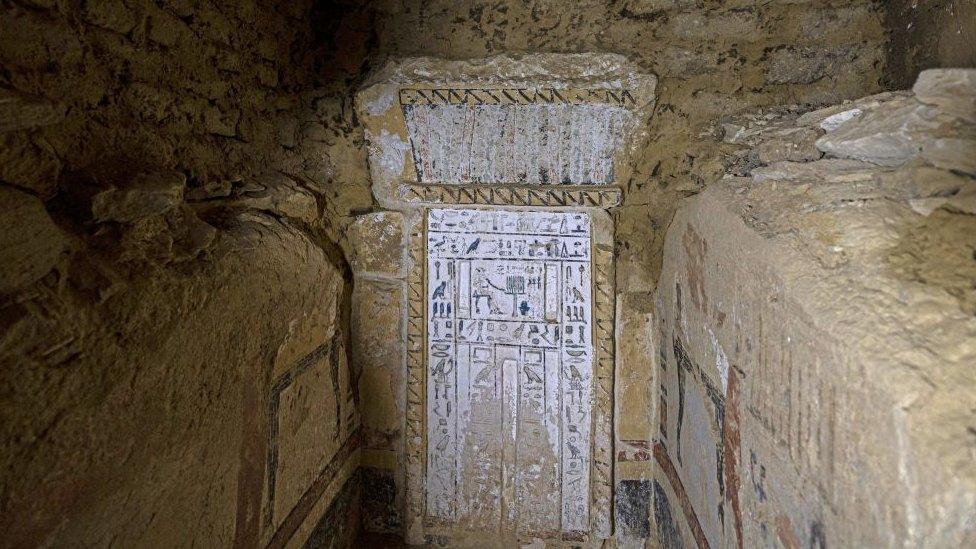Ancient Egypt: Huge non-royal sarcophagus discovery
- Published
- comments

Can you see the hieroglyphics on the outside of the tomb?
Archaeologists in Egypt have discovered a sarcophagus that has not been opened for 4,300 years.
It was found alongside three other tombs, 50 feet underground in a burial site near Cairo, in Egypt.
All the discoveries in this excavation have been non-royal, which means the people found weren't former pharaohs, princes or princesses.
One of the people discovered at the site was a secret-keeper, and another one was a priest.
Who was in the tombs?
The archaeologists think they were home to several people who were powerful in Egyptian society, but not members of the royalty.
One of the mummies found was covered in gold - which shows the person must have been rich and important.
This was the sarcophagus of Hekashepes, and they think it could be one of the oldest non-royal tombs ever found in Egypt.
A sarcophagus is a coffin that has been carved with special writing or pictures.
They are usually found inside tombs - the sarcophagus was not usually buried underground. Instead it was put an a big chamber.
Leaders of the country and rich people would usually have a sarcophagus when they died, and have special pictures and markings about their life and the afterlife carved into the side of it.
A sarcophagus could range from carved stone to some extremely fancy designs - depending on your power and wealth in Ancient Egypt. Here's Tutankhamun's sarcophagus complete with its golden mask.
"Secret keeper"
One of the tombs belonged to a man called Meri, who had a very special job - he was a secret-keeper.
This meant he was allowed to do special religious rituals, and was very high up with the royal staff.
Another person found in there was Khnumdjedef - he was a priest, inspector and noble supervisor. This meant as well as being a priest he watched over people in positions of power in Ancient Egypt - the nobles.
They think one of the other tombs belonged to a writer called Fetek. The archaeologists hope they can learn a lot about Ancient Egyptian society from his tomb, as it contains a huge collection of statues.
Ali Abu Deshish, one member of the team, said the discovery is extra important because it "connects the kings with the people living around them". It shows that it wasn't just the pharaohs that were important and influential in society.
These statues were discovered at the site
When were the tombs made?
The gold-covered mummy was found inside a sarcophagus that had not been opened for more than 4,000 years.
Archaeologist Zahi Hawass said he thinks the discoveries date back from 2500 to 2300 BC.
The site where these discoveries have been made was an active burial site for 3,000 years, which means lots of people were buried there.
As well as these tombs, the site also has pyramids, graves for animals, and early Christian monasteries.
The tombs date back thousands of years
A week of discoveries
This isn't the only big archaeological find in Egypt this week. On Wednesday, experts said they discovered a city from the Roman era.
This dates back to the second and third centuries.
Buildings that people lived in, towers and metal workshops where coins and tools were made were all found at the site.
The Egyptian government is hoping to put some of these recent discoveries on display at the Grand Egyptian Museum, which is expected to open this year.
- Published27 January 2023
- Published26 January 2023
- Published27 January 2023
